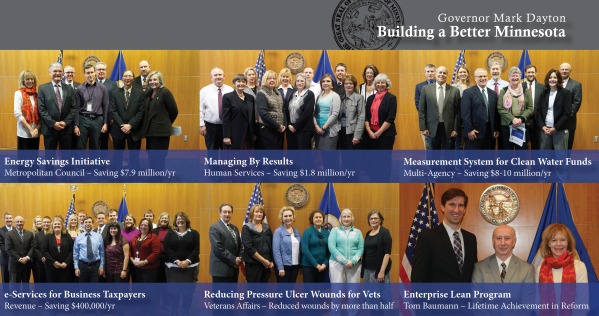Welcome to the Office of the Governor Newsroom. This is where you can find our most recent press releases and other information.
To reach Governor Dayton's Communications Department - please call 651-201-3400.
12/7/2012 10:14:43 AM

ST. PAUL, MN - Today, Governor Mark Dayton recognized more than 50 state employees from ten state agencies for outstanding achievements that have reformed state government and saved Minnesota taxpayers millions of dollars. In the Governor's ongoing effort to build a Better Government for a Better Minnesota, state agencies have been hard at work finding ways to deliver better services to Minnesotans while eliminating wasteful spending, improving efficiencies, and strengthening measures of accountability.
"Reforming government requires creative thinking and a steady resolve to change the way the state conducts its business," said Governor Dayton. "The reform efforts we recognized today are just a few extraordinary examples, among many, of how this administration is building a better government for the people of Minnesota. I thank the employees for their tremendous efforts to improve the quality of services provided to Minnesotans."
The Governor's Continuous Improvement Awards celebrate individual and organizational achievements that have increased the productivity and efficiency of state government services, while improving the delivery and responsiveness of customer service. Forty-three teams from across the administration were nominated for this year's awards, with five receiving recognition at today's award ceremony for their extraordinary achievements.
Energy Savings Initiative
Metropolitan Council
Cost Savings: $7.9 million annually
In 2012, Metropolitan Council Environmental Services (MCES) improved conservation efforts by decommissioning inefficient buildings, installing energy-saving lighting, and completing two major projects, including:
Metro Transit's "Go Greener" initiative is also saving energy by specifying energy-efficient materials when buying buses, adding 97 hybrid-electric buses and changing policy to reduce idling. Additionally, Metro Transit has made its facilities more energy efficient. Through the first three quarters of 2012 alone, Metro Transit conserved an estimated 600,000 gallons of fuel, saving $2.1 million compared to 2007 operations. Compared to 2008, utility costs have been cut in half, saving over $2 million in 2012.
Managing By Results
Minnesota Department of Human Services
Cost Savings: $1.8 million annually
Measurement System for Clean Water Funds
Minnesota Pollution Control Agency, Minnesota Department of Health, Minnesota Department of Natural Resources, Metropolitan Council, Board of Water and Soil Resources, Minnesota Public Facilities Authority, and University of Minnesota
Cost Savings: estimated $8-10 million annually
The Interagency Clean Water Fund Performance Team, comprised of six state agencies and the University of Minnesota, worked together to develop a measurement framework for continually measuring and communicating the results from Clean Water Legacy funds.
While the focus of the work was on measurement and communication, the team used the Six Sigma DMAIC process of defining the scope and issues, creating measures, analyzing data, improving the measures, and creating a report that was released in February 2012.
Within state agencies, this work has been referenced as budgets are being designed for future Clean Water Legacy spending in order to get the best investment for every dollar. Using the measurement results strategically can save Minnesotans millions of dollars in the future as funds are used in proven ways to get results.
Citizens, the legislature, and anyone who wants to learn more about the Clean Water Funds and how they are being used can read about it on the website where the report and information on each data set resides.
e-Services for Business Taxpayers
Minnesota Department of Revenue
Cost Savings: $400,000 annually
In addition to business taxpayers using the system, the Department of Revenue was able to develop a solution using this tool for other government agencies such as state agencies, courts, and counties. They use the system to submit and refer overdue accounts to the Department of Revenue and electronically check on the collection status of those overdue accounts after referrals to the Department of Revenue.
Reducing Pressure Ulcer Wounds for Veterans
Minnesota Department of Veterans Affairs
Quality Outcome: Reduced rate of pressure ulcer wounds by more than half
The Minnesota Department of Veterans Affairs (MDVA) identified an upward trend in pressure ulcer wounds to an all-time high of 10.5 percent. An interdisciplinary wound committee was developed to reduce the rate of pressure ulcer wounds and prevent new wounds from developing. Within three months the committee reduced the pressure ulcer wound rate to 3.1 percent, and maintained a 4.5 percent rate over the last six months, which is well below the national average. To achieve this reduction, the committee:
Enterprise Lean Program
Tom Baumann, Minnesota Department of Administration
More than 300 reform events, each resulting in average time savings of 66% and average cost savings of over $105,000
Tom Baumann has been leader of the Enterprise Lean program since 2008. In that time, Tom has trained thousands of state and local government employees in the Lean Continuous Improvement principles. He has created a system that has certified nearly 900 employees to facilitate Lean continuous improvement events, known as Kaizen events. Many agencies and local governments are able to undertake their own Kaizen events due to Tom's training. As a direct result, state agencies have conducted approximately 300 Kaizen events resulting in an average time savings of 66 percent and cost savings of over $105,000. Those are real and measureable results.
Tom's work has made Minnesota a recognized national leader in Lean and continuous improvement. Other states are looking to Minnesota as a model for their new programs.